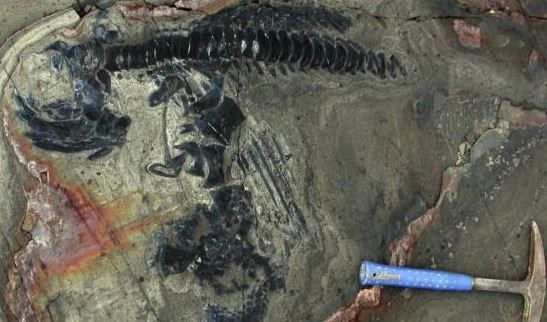Scientists have uncovered a vast graveyard of ancient marine reptiles hidden under a glacier in southern Chile.
In a new study published in the Geological Society of America Bulletin, the researchers document the discovery of the remains of 46 ophthalmosaurid ichthyosaurs (marine reptiles) at the Tyndall Glacier in the Torres del Paine National Park of southern Chile.
The nearly complete skeletons included both embryotic and adult Ichthyosaurs. The largest specimen measured more than 5 meters, or 16 feet, in length. Some even contained soft tissues, Live Science notes.
“This concentration is unique for Chile and South America, making the fossil site significant internationally,” Wolfgang Stinnesbeck, a researcher from Heidelberg University’s Institute of Earth Sciences in Germany and leader of a study published May 22 in the journal Geological Society of America Bulletin, said in a statement.
The discovery of the Ichthyosaur graveyard in Chile has been described as the greatest find of Ichthyosaurs ever and establishes the park as the primary site for Early Cretaceous marine reptiles worldwide.
“It’s the most recent great find in their history,” Christian Salazar, a paleontologist and natural history museum curator in Germany, told The Independent. “That’s going to answer a lot of questions about how they became extinct, where they migrated to and how they lived.”
Scientists actually uncovered the fossil graveyard in 2004 after it was exposed by a receding Patagonian glacier. Paleontologists have spent the last few years studying the remote site, which can only be reached by hiking 14 hours through rugged terrain.
Researchers say Chile’s Ichthyosaurs, which resembled modern-day dolphins with their torpedo-shaped bodies, long snouts and flippers, were probably killed during a series of catastrophic mudslides around 150 million years ago. The air-breathing reptiles became “entombed” in a muddy grave at the bottom of an ancient underwater canyon.
“The [Ichthyosaurs] became disoriented in the turbidity currents,” Stinnesbeck said. “They were sucked down hundreds of meters into the deep ocean.”
Ichthyosaurs were around at the same time as dinosaurs and pterosaurs, but may have gone extinct before their terrestrial and avian cousins. Scientists theorize that a global depletion of oxygen in the oceans, brought on by volcanism, may have led to the mass die-off of Ichthyosaurs, Discovery notes.
The first complete Ichthyosaur skeletons were discovered in England in the early 19th century.
Agencies/Canadajournal
 Canada Journal – News of the World Articles and videos to bring you the biggest Canadian news stories from across the country every day
Canada Journal – News of the World Articles and videos to bring you the biggest Canadian news stories from across the country every day



